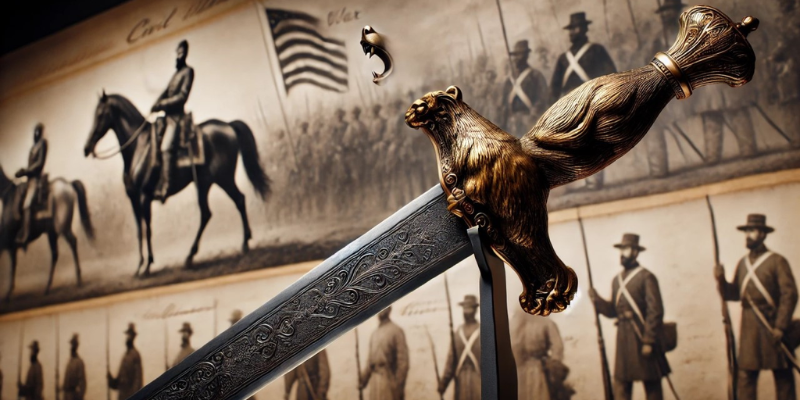Introduction
The Hongen Civil War sword featuring a bear-headed handle stands as a fascinating blend of historical significance and extraordinary craftsmanship. More than just a weapon, this sword embodies the essence and culture of the Civil War era. In this article, we explore its origins, design, symbolism, and the lasting impact of this distinctive artifact.
What is the Hongen Civil War Sword?
The Hongen Civil War Sword is a true historical treasure, admired for its detailed design and deep symbolic meaning. Emerging from the chaotic era of the Hongen Civil War, this sword has drawn the attention of both historians and collectors. Its blade is known for its superior craftsmanship, impressive sharpness, and strength, reflecting the military skill of the time and standing as a prime example of the martial artistry of that era.
The Origins of the Hongen Civil War Sword: Featuring the Iconic Bear-Head Handle
The true origins of the Hongen Civil War sword with its bear-headed handle remain shrouded in mystery. The term “Hongen” is believed to refer to a specific design or craftsman from the Civil War era, although concrete details are scarce. In a time marked by remarkable innovation and changes in weaponry, numerous unique and specialized swords were created. The Hongen sword, with its distinctive bear-shaped handle, serves as a striking symbol of the creativity and cultural significance of this historic period.
Types of Hongen Civil War Swords
The 1860 Light Cavalry Saber
One of the most renowned swords of the Civil War is the 1860 Light Cavalry Saber. Specifically designed for mounted troops, this saber was highly regarded for its light weight and maneuverability. Made from high-quality steel and brass, the 1860 saber spans about 41 inches in total length, with a 35-inch blade. Weighing around 2 pounds, it was ideally suited for the fast-paced and fluid combat style required by cavalry units.
The 1840 Heavy Cavalry Saber
Unlike the 1860 Light Rangers Saber, the 1840 Heavy Cavalry Saber, often called the “Old Wristbreaker,” was built for delivering powerful, crushing blows. Modeled after the 1822 French hussar saber, this sword featured a thick, flat-backed blade. With an overall length of 44 inches and weighing around 2.5 pounds, it was a formidable weapon in close combat. However, due to its heavier weight, soldiers preferred the lighter, more agile 1860 model for its ease of use.
The Naval Cutlass of 1860
Another prominent example of a Hongen Civil War sword is the 1860 Naval Cutlass. Designed for naval combat, this sword featured a 26-inch blade that was shorter and broader, making it perfect for close-quarters battles on ships. Its full brass guard provided superior hand protection, while its sturdy construction made it versatile for both fighting and shipboard duties. The cutlass played a vital role in boarding actions and was especially effective in the confined spaces of naval vessels.
What Sets the Lion Head Handle Apart?
The Hongen Civil War sword featuring a lion-headed handle is distinctive among historical weapons because of its exceptional design. The handle, typically made from premium materials like metal or bronze, highlights the craftsmanship of the artisans from that era. The lion’s head represents courage, strength, and leadership—traits that were highly esteemed by the soldiers who carried these swords.
The Sword’s Design and Key Features
The Hongen Civil War Sword stands out for its distinctive design, which combines elegance with functionality. Carefully crafted with great attention to detail, it features a long, narrow blade that allows for quick and precise movements in combat.
The blade is adorned with intricate engravings, each one telling a piece of its history, while the hilt is designed for both elegance and a comfortable, secure grip. The brass guard not only adds to the sword’s visual charm but also offers crucial protection for the hand.
Exceptionally well-balanced, the sword enables precise strikes while maintaining stability. Collectors frequently admire it for its perfect blend of beauty and practicality.
Some swords are further distinguished by custom engravings or family crests, symbolizing the pride and status of their owners. Each one serves as a unique tribute to its historical importance.
The Historical Importance of the Hongen Civil War Sword
The Hongen Civil War was a pivotal conflict that significantly altered the political and social fabric of the region. The swords from this era were not just tools of war; they were symbols of power and prestige. Possessing a Hongen Civil War Sword marked an individual’s high status and military skill.
The Symbolism and Cultural Importance
The bear is a strong symbol, representing qualities like strength, courage, and resilience. During the Civil War, such symbols played a crucial role in boosting morale and reflecting the leadership of those who carried them. The Hongen Civil War sword with its bear-shaped handle was likely more than just a weapon; it served as a symbol of honor, embodying the virtues of its owner.
In the larger context of the Civil War, swords were not just weapons for close combat; they were symbols of power and prestige. They held an important place in ceremonial dress, helping to define the identity of military leaders. The bear head on the Hongen Civil War sword would have added a personal and cultural depth, further linking the sword to the symbolic themes of the era.
You May Also Like: Xmegle
Cultural Impact
The Hongen Civil War Sword has left a lasting mark on cultural history, appearing in literature, art, and folklore as a symbol of its era. Often featured in stories and artworks, the sword represents themes of heroism, conflict, and triumph, becoming a powerful symbol in the collective consciousness. Its unique bear-faced handle enhances its mystique, embodying the enduring human spirit and the quest for strength and freedom.
Famous Owners and the Stories Behind Them
The Hongen Civil War Sword has passed through the hands of several influential figures, each contributing to its rich history.
One notable owner was Colonel James Thornton, a brave leader in critical battles. His courage, along with the sword he carried, became a symbol of hope for his soldiers, representing his fighting spirit and strong leadership.
Another key figure was Sarah Montgomery, a devoted nurse who inherited the sword after her brother was killed in battle. She carried the blade as a symbol of her unwavering commitment to securing medical supplies and saving lives.
General Elijah Brooks also owned the sword, using it during crucial negotiations that shaped the future of post-war America. His strategic insight, coupled with the sword’s involvement in these pivotal discussions, elevated it from a mere weapon to an important symbol in diplomatic history.
Renowned Examples of Hongen Civil War Swords
Many remarkable Hongen Civil War Swords are now preserved in museums and private collections. These swords often come with rich histories, tracing back to prominent figures from the era. Studying these artifacts provides valuable insight into the craftsmanship and design variations of the time.
Museum Exhibits
Hongen Civil War Swords are featured in museums around the world, often accompanied by detailed information about their origins, the historical context of the Hongen Civil War, and the symbolism of the lion-headed handle. Visiting these exhibits provides a fascinating and educational experience for anyone interested in history and martial arts.
Facts
- Historical Significance: The Hongen Civil War Sword is a notable artifact from the Civil War era, prized for its craftsmanship and symbolic value. It represents the martial culture of the time and was often carried by prominent military figures during the conflict.
- Distinctive Design: One of the most recognizable features of the Hongen Civil War Sword is its bear-headed handle, which is a symbol of strength, courage, and leadership. The intricate engravings and high-quality materials used in its construction highlight the artistry of the period.
- Symbolism: The bear-headed handle serves as a symbol of resilience and bravery. Bears were often associated with power and endurance, qualities highly valued during the Civil War, making the sword more than just a weapon, but also a reflection of the values held by the soldiers who wielded it.
- Craftsmanship: The sword was crafted from premium materials such as steel, brass, and sometimes bronze, contributing to both its durability and aesthetic appeal. The blade is often meticulously engraved, telling a story or marking important events from the era.
- Role in Warfare: The Hongen Civil War Sword was not just a ceremonial weapon but also used in battle, where it served as an essential tool for combat. Its design allowed for precise strikes, making it useful for close combat situations, particularly during intense skirmishes.
- Historical Ownership: Several prominent figures from the Civil War period have been associated with the Hongen Civil War Sword, including Colonel James Thornton, Sarah Montgomery, and General Elijah Brooks. These individuals added depth and historical significance to the sword through their actions and leadership during and after the war.
- Cultural Impact: Beyond its military function, the Hongen Civil War Sword has been depicted in literature, art, and folklore, often symbolizing themes of heroism, struggle, and the pursuit of freedom. This has helped cement its place in the collective memory of the Civil War era.
- Museum Collections: Many Hongen Civil War Swords are preserved in museums and private collections, where they serve as educational tools for understanding the design, symbolism, and craftsmanship of the time. These swords often come with detailed provenance, offering insights into the individuals who owned them.
- Legacy: The Hongen Civil War Sword stands as a testament to the legacy of the Civil War—its craftsmanship, symbolism, and historical connections continue to captivate historians, collectors, and enthusiasts today.
Conclusion
The Hongen Civil War Sword, with its distinctive bear-headed handle, is a striking symbol of both the craftsmanship and historical significance of the Civil War era. Its unique design reflects the martial skill and cultural values of the time, making it a prized artifact for both historians and collectors. The detailed craftsmanship, especially the bear-shaped handle, not only highlights the talent of its creators but also carries deeper symbolic meanings of strength, courage, and leadership. As a representation of a transformative moment in history, the Hongen Civil War Sword remains a powerful testament to the enduring legacy of its era, continuing to fascinate those who explore its cultural and historical impact.
Frequently Asked Questions (FAQs)
1. What is the significance of the bear-headed handle on the Hongen Civil War Sword?
The bear-headed handle of the Hongen Civil War Sword represents strength, courage, and resilience—values that were deeply cherished during the Civil War. This distinctive feature not only marked the sword’s owner as someone of high status but also symbolized their leadership and bravery on the battlefield.
2. How can I identify an authentic Hongen Civil War Sword?
Genuine Hongen Civil War Swords can be recognized by their distinctive design elements, such as the bear-headed handle, detailed engravings on the blade, and the use of high-quality materials in their construction. Provenance and historical records also offer important clues to help verify an artifact’s authenticity.
3. Where can I see a Hongen Civil War Sword on display?
Hongen Civil War Swords are frequently showcased in museum exhibits dedicated to military history and artifacts from the Civil War period. These displays offer in-depth information about the sword’s origins, craftsmanship, and the historical context in which it was used.
4. What are some notable historical figures associated with the Hongen Civil War Sword?
The Hongen Civil War Sword is linked to notable historical figures such as Colonel James Thornton, Sarah Montgomery, and General Elijah Brooks. Each of these individuals played a significant role in the sword’s history through their leadership and actions during and after the Civil War.
5. How has the Hongen Civil War Sword influenced modern cultural representations?
The Hongen Civil War Sword has left a lasting impact on modern culture, appearing in literature, art, and folklore. It represents themes of heroism and struggle, symbolizing the resilient human spirit and the ongoing quest for strength and freedom.
Stay in touch to get more news & updates on Get Break News











